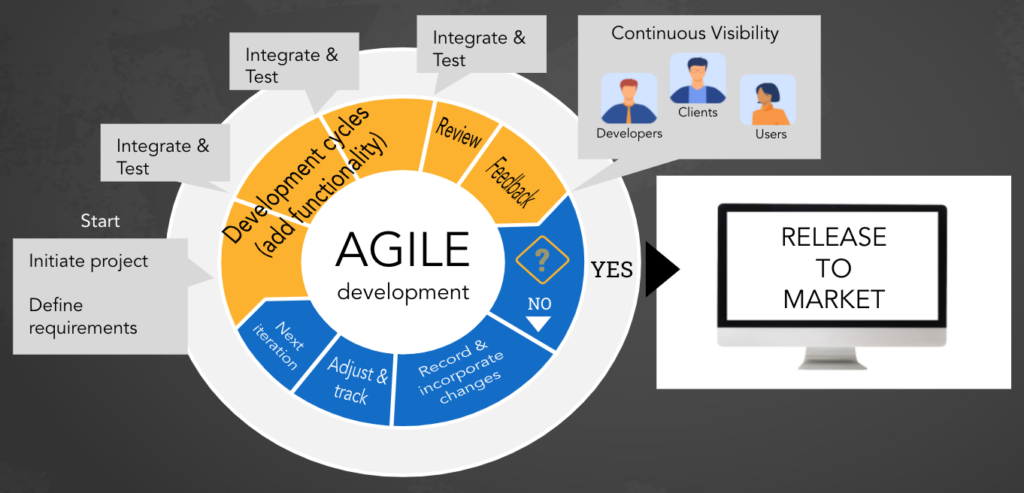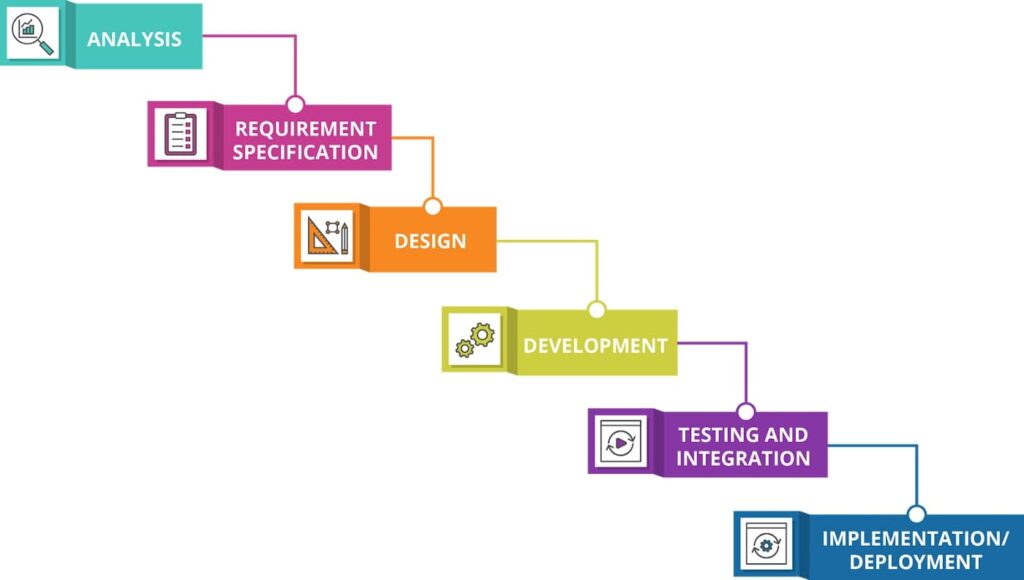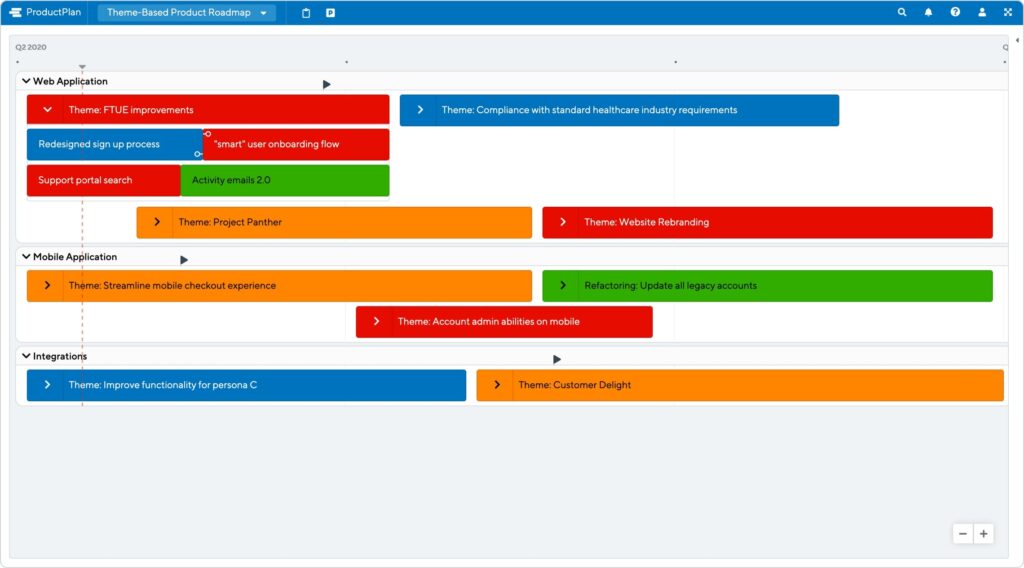For many development teams, the essential question that needs answering before any project begins is: Do we use the Agile or Waterfall approach? While both methodologies involve similar processes, the execution of the various steps is what sets them apart.
Waterfall project management is a traditional, linear approach with successful project delivery as the key driver. Agile development is an iterative approach that deals with achieving customer satisfaction.
This post discusses what Waterfall and Agile methodologies are. We examine the advantages and disadvantages of each development process. We also compare the differences between Agile and Waterfall approaches whilst aligning each development methodology with standard project goals.
To learn more via video, watch below. Otherwise, skip ahead.
What is Agile Project Management?
Agile project management uses an iterative approach with customer satisfaction in mind. This means that the model doesn’t cater only to a single project, but rather to multiple smaller projects. Each smaller project depends on user feedback to drive the development process further.
Agile methodology focuses on continuous releases that incorporate user acceptance testing. A high degree of flexibility within each iteration promotes speed and adaptability in the development process.

Furthermore, it’s a team-based approach where roles overlap. With many phases performed at the same time, Agile development relies on teams working together to achieve their goals by way of continuous improvement.
The Agile model defines time-boxed stages known as sprints with a defined duration of two weeks. Each sprint prioritizes the list of deliverable products based on customer feedback. After each sprint, the development team evaluates the finished project and incorporates notes for future sprints.
Nowadays, customers and businesses require flexibility throughout development projects. Development teams must position themselves to respond swiftly to any change in project requirements.
Agile development benefits from its flexible, iterative approach and customer involvement.
Benefits of the Agile Development Process
- Identifies issues in early-stage development
- High potential for customer satisfaction
- Empowers teams to take charge of complex projects
- Quicker software development lifecycle
- Perfect for projects with non-fixed funding
- Agile team members create better connections
Drawbacks of Agile Methodology
- The project outline and critical path are unknown
- Agile requires high customer involvement, where some customers are not willing
- Time-boxed approach may hinder productivity, requiring additional sprints and capital
What is Waterfall Project Management?
Waterfall project management has a sequential approach and uses distinct phases throughout the development project.
Waterfall methodology entails incremental progress by defining each step in the development process. A project manager defines all goals, project phases, and budgets at the start of the development project.

Credits: Medium
The Waterfall method denotes that teams must complete and approve each previous phase before moving on to the next phase. Upon completion of a phase, it is difficult to revisit previous phases as it threatens to derail the whole project. Agile teams use a similar process to the Waterfall approach, but break each phase down into smaller projects with continuous feedback loops.
Since each project team plays an essential role, Waterfall requires a handover of the project between each development phase.
Setbacks and delays in the design phase prove expensive for the next phase, given the rigid structure of the Waterfall model.
Benefits of the Waterfall Development Process
- Whole-system approach with defined goals
- Required deliverables requirements established at the start allow easier planning and budgeting
- Well-defined team roles create transparency and accountability
- More focus on product designs and requirements documentation
- Spends less time adapting to project needs as per each phase
Drawbacks of Waterfall Methodology
- Doesn’t allow for uncertainty within the full scope of the project
- Difficult to share work because of strict phases and specialized teams
- Time wasted during phases due to the approval process and project handoff
- Need additional team members for specialized work, whereas Agile methodology promotes cross-functional teams
Agile vs Waterfall Project Management
The difference between Agile and Waterfall methodology lies in the execution of the development process. Both collaboration tools contain the same steps. These steps are
- Conception
- Initiation
- Analysis
- Design
- Construction
- Testing
- Deployment
The key difference between Agile and Waterfall is that teams perform Agile steps at the same time and use an incremental approach with constant feedback. This style of work is efficient when performed well. However, Agile requires utmost flexibility and adaptability to realize its advantages.
Waterfall methodology works with a sequential approach and defined phases. Teams put all their energy into a single phase in the Waterfall model before moving to the next phase.
In general, the traditional approach works well since teams are focusing on one phase at a time. Yet, there is no allowance for one phase to delay or deviate from the critical project path. This leads to disaster and the potential for a complete project restart.
Hence, the Waterfall model requires strict planning and implementation. On the other hand, Agile methodology allows for the continuous revisiting of phases throughout the development lifecycle in the form of sprints. This incremental approach lets teams review their work as they go on and achieve many smaller wins.
More and more organizations are adopting the Agile development methodology for this reason alone as they know that visible progress boosts morale within the project team.
Furthermore, Waterfall requires dedicated project managers to lead the way. Agile approaches empower team members to operate without a project manager. Thus, encouraging efficient communication between team members.
The full-scope approach of Agile introduces a product mindset to the team. The main focus is to adapt the product for ultimate customer satisfaction and increase the business value. Waterfall development’s main objective is to provide successful project delivery.
How do you Choose Between Agile and Waterfall?
The Agile approach is the best option to implement for an organization that has a high level of complexity and a short timeframe to complete projects. The design of Agile methodologies caters to projects where major challenges are unknown and often unsolvable.
Waterfall provides good results for projects with a clear deadline and clear delivery schedule. Companies use Waterfall to overcome complexity and dependencies through strict planning.
Waterfall is the preferred approach if you understand the main project constraints. The design of Agile targets development projects where the constraints are undefined. For example, it’s difficult to predict the timeline and budget when developing a new product.
Agile development methodology is flexible and allows for the work to evolve as the project progresses.
Aligning Development Methodologies With Project Aims
There are a few factors to consider when deciding which method to use for your project. You must create your own process framework where you define your development process.
Customer Involvement
Agile prefers for customers to be available throughout the project. Waterfall only includes customers at project milestones.
Customer feedback reduces risk in both methodologies because development teams get a clearer picture of requirements.
Scope/Features of the Project
Agile welcomes deviations from the project path, but at the cost of time and other features. It works for projects that don’t have a defined scope.
Waterfall works with a defined scope and project teams agree upon terms at the start of the project. Change and error are inevitable. Thus, the development team needs space to adapt. Fixed contracts are restrictive.
Feature Prioritization
Customers prioritize features by value in Agile development. This ensures that they incorporate the most important features first. Thus, preventing the result of an unfinished product when funding dries up. Ends in partial success rather than a complete failure.
Waterfall sticks to the agreed framework. Thus, ensuring that the customer receives all features which they requested. This presents a larger risk of failure without any compromise.
Team
Agile prefers smaller teams that work cross-functionality with high-level communication and synchronization.
Waterfall only requires team communication between phases and handoff points.
Teams work better when there is good communication, but it depends on the project requirements. High-level synchronization in the development team is not always necessary.
Funding
Agile works well in non-fixed funding scenarios but is not well suited for fixed-price contracts. Waterfall mitigates the risk of fixed-price contracts by agreeing on terms at the start. Determining a fixed price is difficult when the scope is not defined.
Agile vs Waterfall for Software Development
Both development methodologies are sure to help software development companies provide high-level project management. However, more organizations are moving from the traditional Waterfall method to the flexible Agile method for software projects.
The reason for this is that software development project goals are never set in stone. Software development requires continuous user feedback and utmost flexibility to deliver the best results possible.
Since many companies still value the Waterfall approach, it is difficult to change tactics. Yet, the results are worth it once they make the transition.
Factors to Consider When Moving to Agile
Making the change to Agile calls for a number of process alterations. This is evident when using a DevOps approach, where both the development and operations teams drive software development and maintenance.
Companies that want to move to Agile must embrace the following two crucial factors:
- The customer is responsible for optimizing the team’s output through constant feedback. The team depends on the customer to prioritize the most important features. This way, the customer receives the best possible product based on their feedback.
- The Agile project team does not accept more work than what is possible. The customer doesn’t put additional stress on the software development company by pushing for additional work or tight deadlines. The team pulls prioritized work from the backlog once it’s ready to take on new work.
Mechanisms of the Agile Model
Roadmaps
A project roadmap lays out the development of a solution or product over time. Roadmaps contain initiatives with high degrees of functionality. These include rough timelines and project requirements.

Credits: Product Plan
The purpose of the roadmap is to have long-term goals in mind while focusing mainly on the current situation and its impact on the end result.
Requirements
Agile requirements are lean descriptions of necessary functionality for the project to succeed. The requirements change over time and capitalize on the holistic approach to understanding the customer and the product.
Backlog
The backlog is responsible for prioritizing the requirements of the Agile program. Teams include all work items in the backlog such as software development enhancements, technical fixes, new features, etc. The team then uses the backlog as its only source of work.
Agile vs Waterfall Project Management: Key Takeaways
Agile is a solid approach not only for software development. It empowers all teams to work together and achieve high customer approval. Companies that aren’t ready to convert fully to Agile have also shown success in a Waterfall-Agile combination.
We hope that this guide has provided you with the necessary tools to take charge of your next big project. Using the correct method is critical to success.
